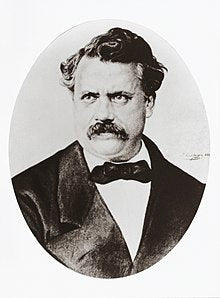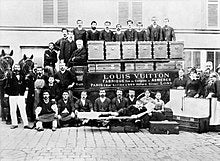
The full history of Louis Vuitton
The full history of Louis Vuitton
Louis Vuitton is today one of the world's leading fashion houses, but the brand's history stretches back more than 150 years. The history of Louis Vuitton is a fantastic tale of innovation, quality and expansion.
Gaston Louis Vuitton (both the name of the founder, and later the brand itself) was born in 1821 in a small village in eastern France. When he turned 16, he went all the way from his new home Jura to Paris. He walked about 470km and it took him two years. He arrived in 1837 and began an apprenticeship with Monsieur Marechel, a successful trunk maker. Here he learned the art of designing and manufacturing robust and durable suitcases and travel bags that could withstand the harsh travel conditions of the time. In just a few years, Louis Vuitton gained a reputation as one of Paris' best trunk makers. 
After Napoleon III re-established the French Empire, Louis Vuitton was employed as the personal trunk maker and packer for Eugénie de Montijo, who was married to Napoleon III. This job gave him access to exclusive and royal clients throughout France, this clientele, was the starting point for his own business.
In 1854, when he was 33 years old, he married Clemence-Emilie Parriaux, and founded the company named after him, Louis Vuitton. He opened the first store on Rue Neuve des Capucines in Paris. At the shop there was a sign that read "Safe packing of the most sowable objects. Specializing in the packaging of fashion”. Here he began to produce his own suitcases and travel bags, and his products quickly became popular among wealthy travelers in Paris. Vuitton was known for using the best materials and the latest technology to create durable and elegant suitcases and travel bags.
In 1858, Louis Vuitton began producing the classic square suitcases, which differed from the other brands, which were often round at the top. The flat top made the bags easier to stack.

In 1886, Louis Vuitton and his son also designed the first locks, which were supposed to be impossible to open without the original key. In the coming years, Louis Vuitton expanded its range and began to produce other types of luxury goods, including purses, belts and gloves. In the 1870s, Louis Vuitton passed to his son, Georges Vuitton, who led the company into the 20th century. Georges Vuitton continued to develop new products and materials, including the first hard-shell suitcase called the "Squire".
In 1896, Louis Vuitton's son, George Vuitton, invented the iconic Vuitton pattern that is still known and recognized today as a tribute to his father. The pattern consisted of the familiar letters "LV" and a floral motif, and it quickly became a symbol of quality and style. The original name for the pattern was “Damier”. The Vuitton pattern also became an effective way to protect against counterfeiting as it was difficult to copy.
In 1930, Louis Vuitton introduced its first handbag, which was called the " Keepall ". The bag was an innovative solution to a problem faced by many travelers at the time: carrying a large amount of luggage without losing style. An elegant and practical bag that could hold everything a traveler needed, the Keepall quickly became popular with the wealthiest and most stylish travelers.
In the decades that followed, Louis Vuitton continued to expand its range and presence worldwide. In 1987, Louis Vuitton merged with the champagne producer, Moët-Hennesey, to become the French luxury conglomerate LVMH, which still owns and operates the brand today. Under LVMH's leadership, Louis Vuitton has continued to expand its range and brand globally. The company now has more than 460 stores in 50 different countries and offers a wide range of products, including bags, purses, shoes, clothing and accessories.
Louis Vuitton is also known for its collaborations with some of the world's leading artists and designers. The company has collaborated with artists such as Takashi Murakami, Yayoi Kusama and Jeff Koons, and designers Marc Jacobs and Virgil Abloh.
Louis Vuitton is also committed to sustainability and social responsibility. The company is committed to reducing its environmental impact and has launched a number of initiatives to achieve this goal. Louis Vuitton is also actively involved in the communities in which it operates, supporting a number of social and environmental initiatives.
Louis Vuitton has achieved a status as one of the world's most iconic and respected fashion houses. The company has managed to preserve its heritage and traditions while continuing to develop and create new trends and products. An iconic representation of French elegance and style, Louis Vuitton continues to be a driving force in the fashion industry and a global cultural institution.



